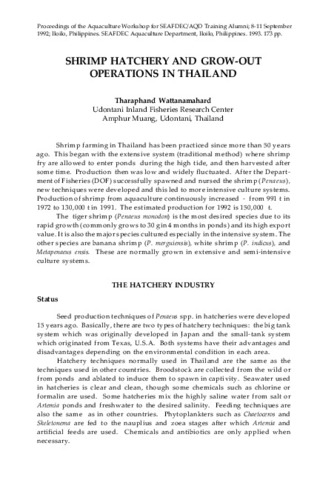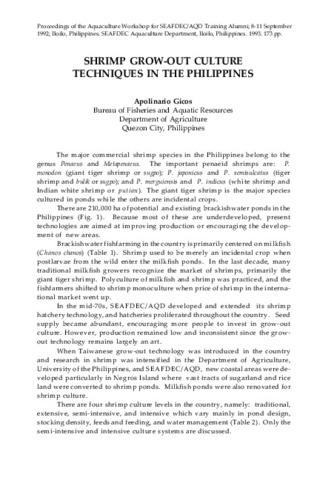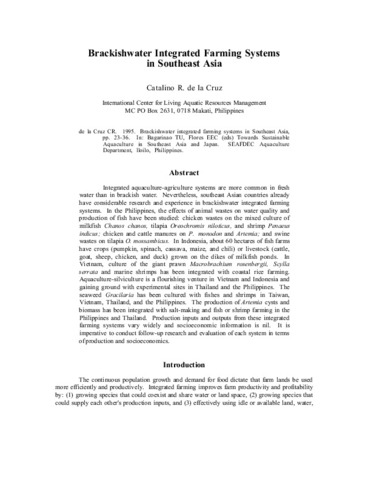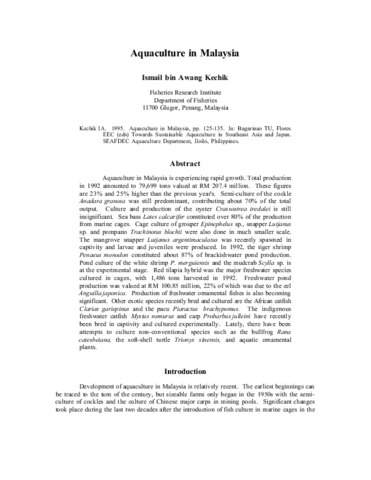Shrimp hatchery and grow-out operations in Thailand
- Global styles
- MLA
- Vancouver
- Elsevier - Harvard
- APA
- Help

Date
1993Author
Page views
4,456ASFA keyword
AGROVOC keyword
Taxonomic term
Metadata
Show full item record
Share
Abstract
Shrimp farming in Thailand has been practiced since more than 50 years ago. This began with the extensive system (traditional method) where shrimp fry are allowed to enter ponds during the high tide, and then harvested after some time. Production then was low and widely fluctuated. After the Department of Fisheries (DOF) successfully spawned and nursed the shrimp (Penaeus, )new techniques were developed and this led to more intensive culture systems. Production of shrimp from aquaculture continuously increased - from 991 t in 1972 to 130,000 t in 1991. The estimated production for 1992 is 150,000 t.
The tiger shrimp (Penaeus monodon) is the most desired species due to its rapid growth (commonly grows to 30 g in 4 months in ponds) and its high export value. It is also the major species cultured especially in the intensive system. The other species are banana shrimp (P. merguiensis), white shrimp (P. indicus), and Metapenaeus ensis. These are normally grown in extensive and semi-intensive culture systems.
Suggested Citation
Wattanamahard, T. (1993). Shrimp hatchery and grow-out operations in Thailand. In C. T. Villegas, M. T. Castaños, & R. B. Lacierda (Eds.), Proceedings of the Aquaculture Workshop for SEAFDEC/AQD Training Alumni, 8-11 September 1992, Iloilo, Philippines (pp. 9-12). Tigbauan, Iloilo, Philippines: Aquaculture Department, Southeast Asian Fisheries Development Center.
Type
Conference paperISBN
9718511253
Related items
Showing items related by title, author, creator and subject.
-
Shrimp grow-out culture techniques in the Philippines
Gicos, Apolinario (Aquaculture Department, Southeast Asian Fisheries Development Center, 1993)The major commercial shrimp species in the Philippines belong to the genus Penaeus and Metapenaeus. The important penaeid shrimps are: P. monodon (giant tiger shrimp or sugpo); P. japonicus and P. semisulcatus (tiger shrimp ... -
Brackishwater integrated farming systems in Southeast Asia
De la Cruz, Catalino R. (Aquaculture Department, Southeast Asian Fisheries Development Center, 1995)Integrated aquaculture-agriculture systems are more common in fresh water than in brackish water. Nevertheless, southeast Asian countries already have considerable research and experience in brackishwater integrated farming ... -
Aquaculture in Malaysia
Kechik, Ismail bin Awang. (Aquaculture Department, Southeast Asian Fisheries Development Center, 1995)Aquaculture in Malaysia is experiencing rapid growth. Total production in 1992 amounted to 79,699 tons valued at RM 207.4 million. These figures are 23% and 25% higher than the previous year's. Semi-culture of the cockle ...






